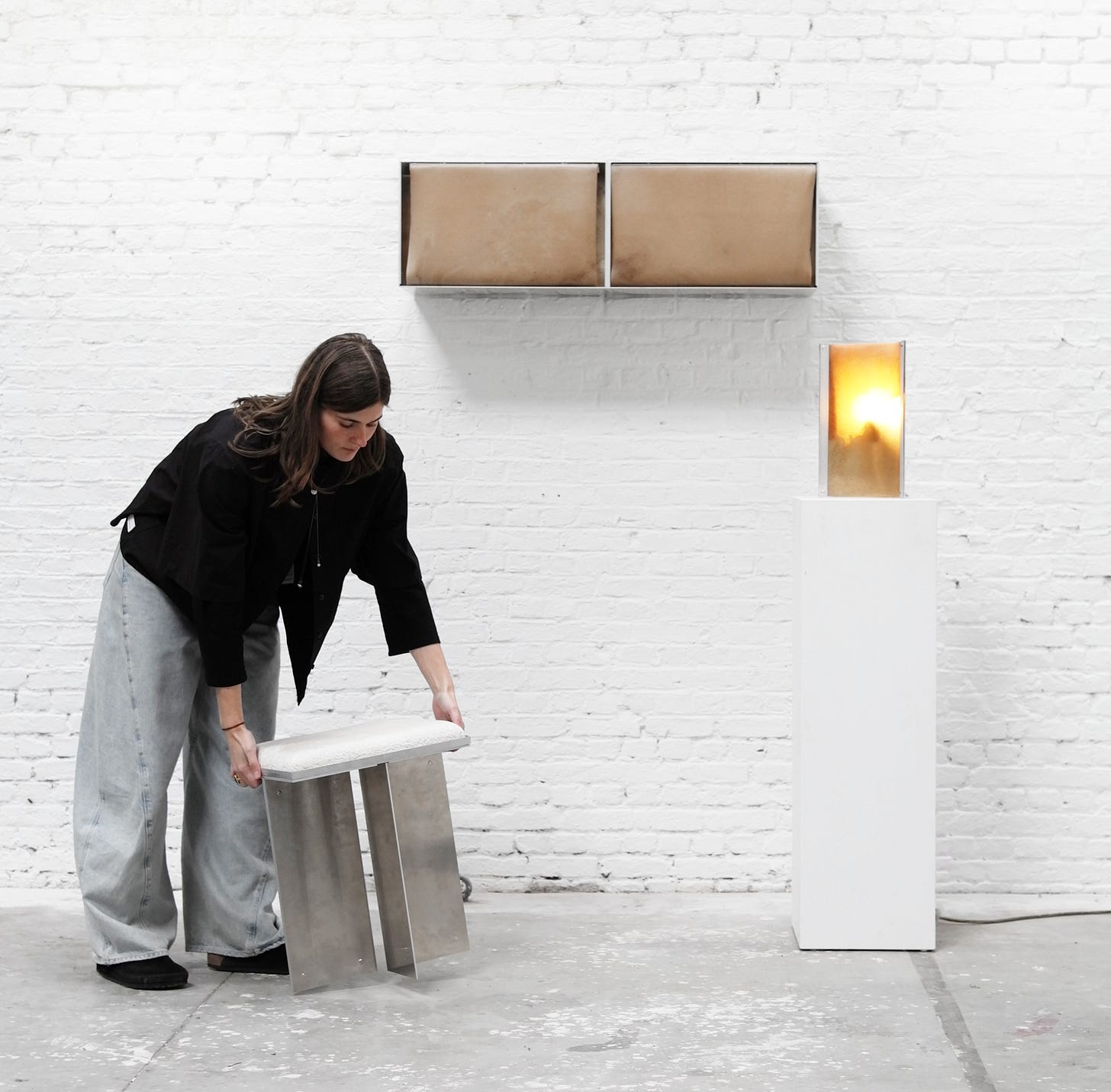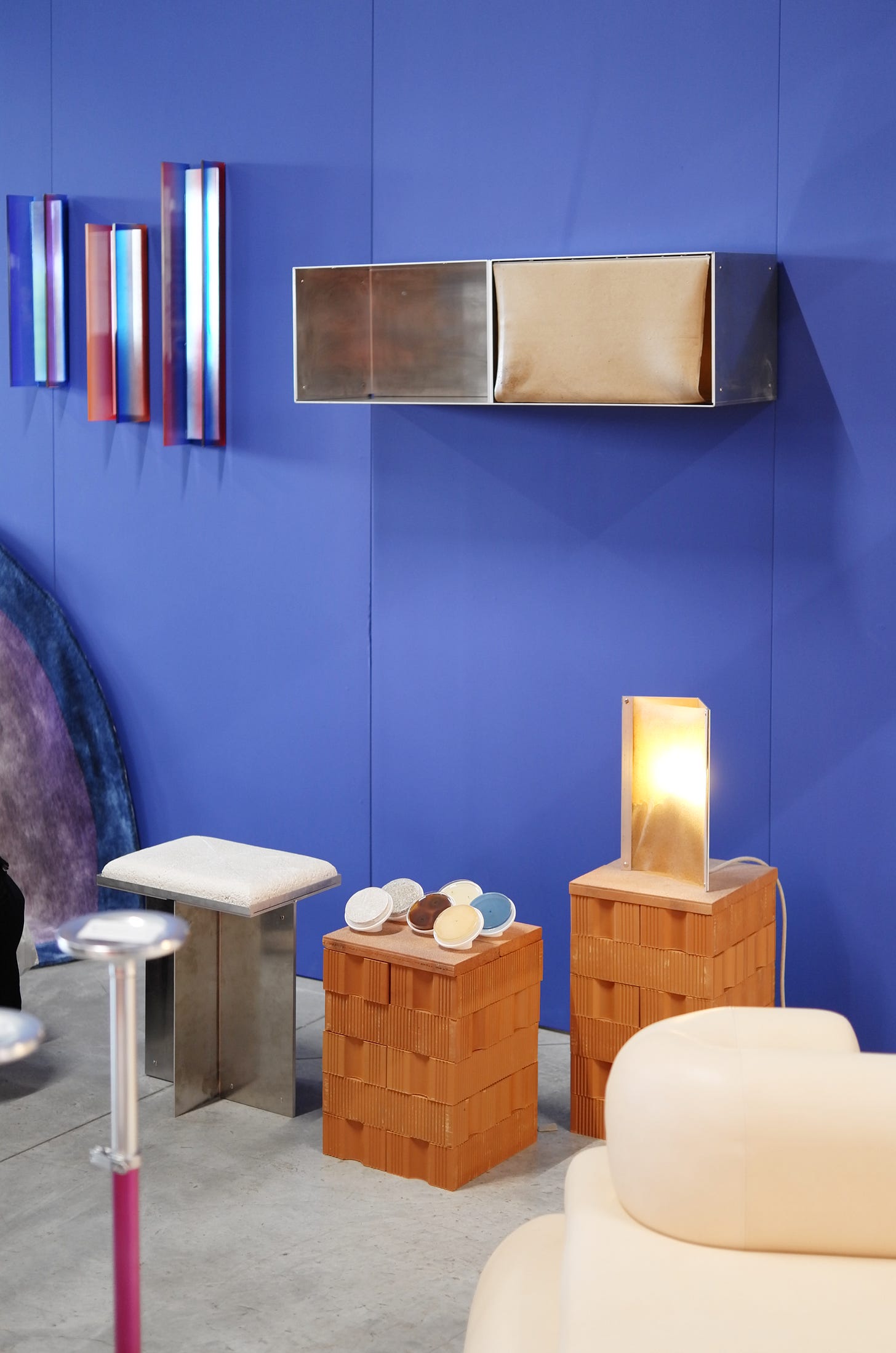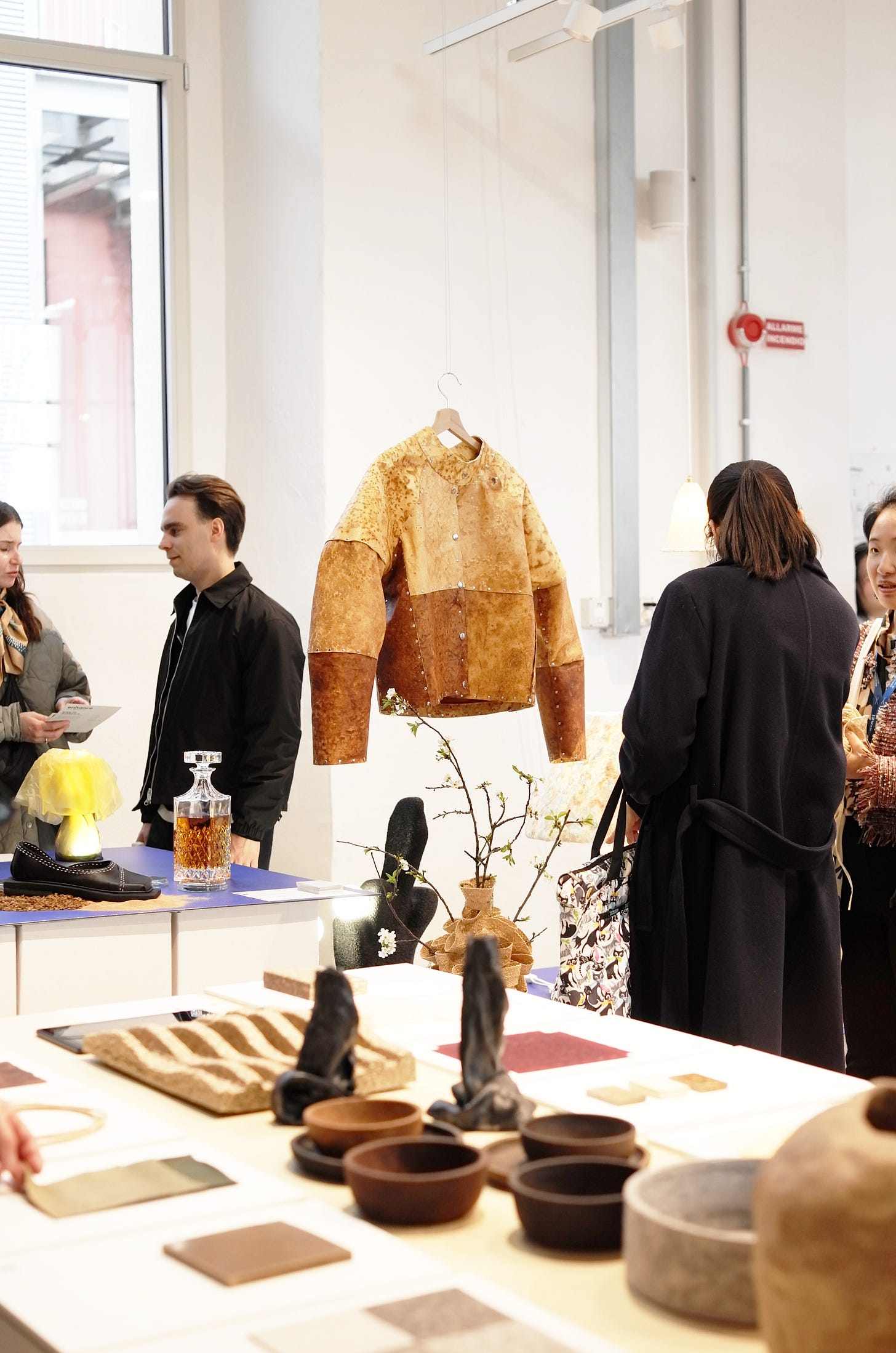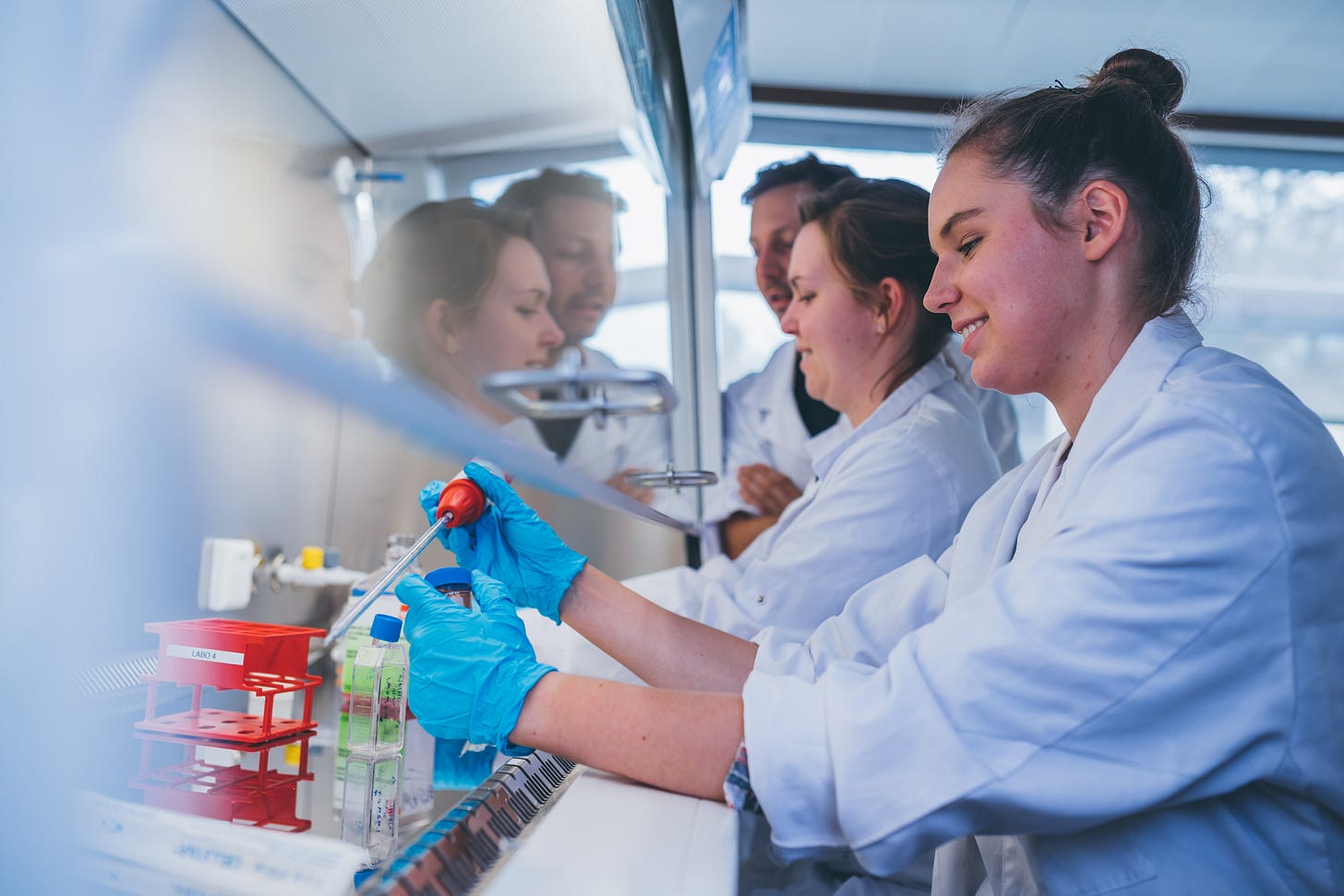As a researcher working at the intersection of biology and design, I find myself constantly reflecting on what it truly means to blur disciplinary boundaries. Here at Vrije Universiteit Brussel (VUB), that concept isn’t just a noble ideal, we practice it every day, most visibly through our PhD researchers, Annah-Ololade Sangosanya and Anouk Verstuyft, whose projects are on display at Milan Design Week 2025.
Annah originally trained as a bioengineer, immersed in rigorous scientific observation and experimentation. Anouk, on the other hand, has a background in design, where the focus lies on creative expression and hands-on engagement with materials. Over time, though, I’ve watched their strictly defined roles begin to overlap and evolve. Annah started to see biology through a designer’s lens, growing fungi not just for scientific study but to reimagine fashion. Meanwhile, Anouk brought scientific precision into her design process, experimenting with fungi to craft sustainable furniture.
What fascinates me most about their transformations is that they extend far beyond simply acquiring new skills. At its core, this evolution involves learning to be at ease in those spaces where rational analysis meets intuition, passion, and aesthetics. In my view, science is itself an open system, one that requires creativity and curiosity every bit as much as it demands methodological rigour. Our lab culture, envisioned and led by Prof. Eveline Peeters, arose from this realisation. It’s a setting that might seem unusual in conventional scientific circles, but I believe it’s precisely what enables boundary-blurring innovation.
Of course, creating an environment that supports such fluid roles calls for more than just rethinking curricula or introducing co-mentorship. We need adaptable infrastructure, thoughtful funding structures, and institutional policies that encourage (and reward) collaborative, cross-disciplinary work. At VUB, for instance, we’re building lab spaces that comfortably host both sterile biological research and the inevitable messiness of hands-on design exploration. We’re also making the case for funding bodies to see genuine value in interdisciplinary outcomes, and we continue pressing our institution to ensure research across multiple fields is recognised fairly.
For me, mentoring hybrid researchers like Annah and Anouk has underscored that boundary-blurring breakthroughs often arise from a deeper cultural shift: one that motivates people to keep redefining their professional identities and remain open to very different viewpoints. Slowly but surely, our lab at VUB is taking shape as more than just a location. It’s a lively ecosystem of constantly evolving ideas, methods, and individuals. And now that I see Annah and Anouk’s work presented on the world stage at Milan Design Week, it reaffirms my belief that the future of research lies right here, where separate disciplines converge.
In the following paragraphs, I’ll share an in-depth look at the tools, infrastructures, and educational philosophies that underpin our work at the intersection of biology and design. I’ll also explore the institutional policies and funding models that can make or break these kinds of collaborations.
1. Educational models for hybrid biodesign researchers
From my perspective, interdisciplinary education is the bedrock for cultivating hybrid researchers who can comfortably navigate both biology and design. Our academic programmes often operate in silos, leaving graduates without the skills needed to tackle complex global challenges.
Interdisciplinary curricula could weave scientific and design learning that couples basic lab literacy with systems-based design thinking and hands-on projects, enabling design students to design with living organisms. Student would both learn fundamental biology lab techniques while also learning iterative prototyping and critique. In my experience, it’s crucial that such programmes emphasise ethical and environmental considerations. Through group discussions, they would be confronted with broader ecological and cultural questions, embedding sustainability and ethics into the creative process.
Cross-disciplinary mentorship has also proved vital in our lab. In an educational program students with backgrounds in architecture or design could be paired with student from biology or chemistry to foster a rich exchange of ideas and practices. Also, both my mentors are an architectural engineer professor and a microbiology professor, and jointly mentored PhD and master students, guiding them through aseptic lab techniques and creative expression. I think that programmes that set up dual supervisors ensure balanced guidance.
Another key element is fostering critical thinking and creativity. Platforms like the international Biodesign Challenge illustrate this perfectly: students develop everything from experimental biomedical devices to microbial-based materials and art installations, melding problem-framing from a design angle with systematic testing from a scientific angle. Methods such as speculative design and design fiction help students envision future scenarios of biotech applications and weigh their implications. Perhaps most significantly, students sharpen their communication abilities and learn to explain biology to non-scientists and articulate design proposals to researchers. This shared vocabulary is what truly cements interdisciplinary collaboration.
2. Lab infrastructure to support interdisciplinary biodesign research
Nurturing the union of biology and design also demands physical spaces where both can flourish. In my lab, for instance, we blend the cleanliness and rigour of a wet-lab environment with the experimental openness of a design studio. On any given day, a researcher might be engineering microbes under sterile conditions, then head to the workspace to prototype a new product idea.
Certain equipment is non-negotiable for biological work: incubators to manage growth conditions, laminar flow hoods to preserve sterility, and autoclaves to ensure safe sterilisation. Of course, advanced tools like microscopes, centrifuges, PCR machines, 3D printers or material testing machines can expand the lab’s capabilities, though not every biodesign project requires the same level of hardware. If there’s one thing I’ve observed, it’s how resourcefulness goes a long way. Some labs might repurpose a rice cooker for sterilising small items, while others invest in cutting-edge imaging technology.
We also take biosafety seriously, which means establishing zones where sterile procedures happen away from the ‘messier’ design tasks. This sort of zoning allows both creativity and rigour to thrive in the same facility.
Community makerspaces and grassroots bio-labs have also shown me that not all interdisciplinary biodesign relies on state-of-the-art facilities. These collaborative environments can be lower-tech yet still foster remarkable innovations, partly because they emphasise a do-it-yourself spirit and make lab access more inclusive. Forming partnerships with such spaces can be hugely beneficial. At VUB, we have access to an open fablab and an open biolab. These spaces are primarily dedicated to students and researchers, but they also organise open days which encourages a wider segment of the public to explore and brings fresh perspectives into academic research.
3. Institutional policies and culture supporting science–design collaboration
Universities often have deeply ingrained structures (hiring protocols, tenure rules, departmental budgets) that aren’t geared towards cross-disciplinary endeavours. In my own experience, supporting true collaboration means rethinking these frameworks.
A strategy which we sometimes use is joint appointments, whereby a researcher is anchored in two different fields, often two different faculties. This approach ensures interdisciplinary work is formally recognised and not marginalised during evaluations or budget allocations. But clarity is critical here: from teaching loads to how a candidate’s interdisciplinary achievements will be assessed. For example, freshly hired PhD researchers might be asked to take courses in other fields.
I’m also convinced that promotion and tenure policies must adapt (and they are slowly). Academics pursuing interdisciplinary work often publish in journals outside their traditional domain, or perhaps they focus on patents, exhibits, or community-based research. I’d like to see more universities broaden their evaluation criteria to include public engagement, team-based contributions, and work that spans diverse fields. This would prevent promising scholars from feeling they have to choose between personal career stability and boundary-pushing research. Moreover, being tenured in different faculties seems like a very challenging role. Teaching and faculty tasks need to be clearly defined over all the departments and faculties.
Institutions can encourage discipline mixers, cross-listed seminars where scientists and designers exchange ideas. In our lab, these informal touchpoints have often sparked unexpected alliances and new proposals. When it comes to tackling obstacles, having a business/project manager who truly understands interdisciplinary work and is appointed centrally can make all the difference. A bit of structural support can do wonders for maintaining momentum.
Lastly, evaluating the success of an interdisciplinary lab should look at the bigger picture. Of course, we track papers and prototypes, but we also ask: Are we generating holistic solutions? Are our students coming away with stronger collaborative skills? Is the public engaged with our outcomes? These broader metrics reflect the real impact of bridging biology and design.
4. Funding interdisciplinary project proposals
Another challenge I’ve encountered is that many funding bodies tend to favor projects that align clearly with a single discipline. For example, if your core research is rooted in microbiology but the project itself heavily incorporates design or engineering, it becomes difficult to frame the proposal through just one disciplinary lens. Review panels are often composed of experts with a mono-disciplinary background, which means they may overlook or undervalue the innovative contributions coming from other fields (even if they are generalists within their own domain). While interdisciplinary panels do exist, they typically require you to compete with projects from across the entire research spectrum, which can be a disadvantage. Ideally, I would prefer to submit proposals within a core field, say, microbiology, while having the flexibility to nominate a panel member from a complementary field such as design.
In the end, establishing and nurturing an interdisciplinary biodesign lab is a complex but deeply rewarding process. Annah and Anouk’s journeys exemplify the kind of deeper dialogues that emerge when disciplines genuinely intersect. Watching them grow into hybrid researchers is inspiring and instructive. They, and almost all members in our team, embody a way of working that is curious, collaborative, and unafraid to dwell in the in-between spaces. It’s this spirit that we continue to cultivate, and which, I believe, could guide interdisciplinary research more broadly.






